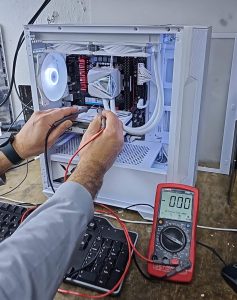
Case Study: Full Gaming PC Repair & Cooling System Replacement – Camden / Kentish Town
Case Study: Full Gaming PC Repair & Cooling System Replacement – Camden / Kentish Town 1 Dec , 2025 Facebook Twitter Youtube Instagram At around

@geekscallout
10th Oct, 2022

Many have gone through the issue of window updates getting stuck during startups and shutdowns at some point in their lives. You may see a message like “Windows is installing updates, do not turn off the computer” or a similar message in this vein.
So, if your computer won’t update when shutting down and freezes, you don’t have to worry because there are a few solutions you may try to fix the problem.
Some updates could take longer than others to install; therefore, you must make sure that the screen is really stuck before you try things out. You must wait 3.5 hours at least to ensure that the updates are frozen. So, you don’t create more issues by implementing methods that are unnecessary while Windows is just taking its time to install everything and finish the process.
Try accessing the Windows by logging in to your account via the Ctrl + Alt + Del command. This might unfreeze the updates and allow them to continue the process of installation, meanwhile, you can use the laptop to work and carry out activities as usual.
Turn the power button off to force the shutdown and turn it back on. This would allow Windows to start normally and continue the update installation. If this doesn’t do the trick, you would have to do a hard reset by removing the battery.
You can choose to boot the Windows in Safe Mode via the Startup settings. For Windows 10, press and hold the Shift key, then select Restart from the Windows power menu. Choose Troubleshoot > Advanced Options > Startup Settings > and then Restart. After the windows turn on, select F4 or Fn+F4 as per the on-screen instructions to start the laptop in Safe Mode.
Only the essential programs run in Safe Mode, so hopefully, windows can complete installing updates there, given the conflict or error with another program goes away. After the successful completion of the process, you may restart to go back to the usual Windows mode.
If you have Windows 10, type “Windows Update” in the search box via the start button and open the page. If Windows has already identified the error, it may warn you about it and send a message regarding the turbulence in the process.
You may also click on “Advanced Options” and check on the installed update history. That’ll let you know how many updates installed and how many are still pending. You may stop the installation of the pending update and check if the system resumes fine.
If you type “Troubleshooting” in the search bar at the start and click on it, you’ll see a bunch of options. Under “System and Security” you’ll find “Fix problems with Windows Update.” Click on it and let the diagnostic tool take care of the rest. This utility is available in most versions of Windows. Though if you upgrade to Windows 11 which is the latest OS version, chances are you will less likely to encounter any update issues.
Restoring the system back to a certain time and date would undo the changes made to the OS. It won’t delete your personal files, photos, or documents. So, it would be safe to restore the system back to the point where it worked flawlessly, fixing the update issues.
You may type “System Restore” in the search bar at the start to access it and complete the wizard to activate it. You can also access the “System Restore” from the “Advanced Options” so even if Windows is not available, you can access these features from the Troubleshoot menu. In Windows 10, and 11 the System Restore can only be accessed from the Troubleshoot menu whereas this function doesn’t exist in Windows XP.
Installations could also get stuck if there’s no storage space to install the system files. In such a situation, you may need to run a disk cleanup utility and delete all temporary and non-essential data to make room for updates installation.
You could also run a memory test to check the RAM’s condition in case it is the one that’s causing trouble. Windows Memory Diagnostic and MemTest86 are free testing tools that inform users about their machine’s memory status.
Viruses could be one reason why your Windows updates might get stuck. So, running an antivirus system may be something that’ll catch the issue and fix it. Once you boot Windows in Safe mode, launch the antivirus program and scan the laptop.
If it detects a malware, it means the malicious code was the culprit that was meddling with the updates, stopping them from loading. You may remove the malware using the antivirus software and restart. The system will go back to normal mode, allowing Windows to start installing updates.
Your last resort would be resetting Windows back to its factory settings after all fixes fail to resolve your problem. Windows reset provides you with options that allow you to keep your personal data saved; however, any third-party software programs get deleted, so you would have to reinstall them again.
In the settings app, you may go to the Recovery tab that’s available on the “Update and Security” window to access the Reset options.
It is crucial that your laptop’s OS remains updated at all times for optimal performance. Windows updates not only close security loopholes by implementing security patches but also install drivers and other essential tools that are required by the system to maintain the device’s longevity and speed. Therefore, updates getting stuck might feel annoying to users who are forced to compromise their work in order to fix the problem and restart the installation process due to its significance.

Case Study: Full Gaming PC Repair & Cooling System Replacement – Camden / Kentish Town 1 Dec , 2025 Facebook Twitter Youtube Instagram At around

Microsoft Surface Laptop 4 (Model 1979) Screen Repair Near Islington – London 25 Nov, 2025 Facebook Twitter Youtube Instagram At Geeks Callout, we receive hundreds

Top Gaming CPUs for Smooth Performance on Call of Duty and Fortnite 20 Aug, 2025 Facebook Twitter Youtube Instagram If you’re in London and have

Reducing Computer Downtime for Small London Firms 27 July, 2025 Facebook Twitter LinkedIn Email Pinterest WhatsApp Small businesses in London face intense operational pressures. Even

Cybersecurity Mistakes That Could Cost You Your Laptop , and Your Data 23 July, 2025 Facebook Twitter LinkedIn Email Pinterest WhatsApp Considering just how interconnected

RTX 5090 vs. RTX 4090: Is the Upgrade Worth It? The graphics card market has been reshaped once again, with NVIDIA unveiling the RTX 5090


